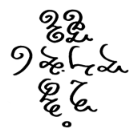-
Posts
2,424 -
Joined
-
Last visited
-
Days Won
180
Monarcheon last won the day on October 6
Monarcheon had the most liked content!
About Monarcheon

Profile Information
-
Gender
Female
-
Location
USA
-
Interests
Cooking, Music, Drama
-
Favorite Composers
Gershwin, Ravel, Webern, Shostakovich
-
My Compositional Styles
Maximalist, Modern-Classical, Musical Theatre
-
Notation Software/Sequencers
Finale 25, Logic Pro X
-
Instruments Played
Cello, Guitar (classical), Piano, Violin, Percussion, Conductor
Recent Profile Visitors
Monarcheon's Achievements
-

2025 Christmas Music Event!
Monarcheon replied to PeterthePapercomPoser's topic in Monthly Competitions
I'm game. Vamos a ver que podemos hacer. -

Key Change
Monarcheon replied to BlackkBeethoven's topic in Incomplete Works; Writer's Block and Suggestions
I'm more of a voice-leading kinda gal, but I came up with this on the fly. I have no idea if it works in the context of your own work, but in general, I'd advise starting with moving lines that mesh well, then filling in gaps. Happy accidents happen all the time! -

Calling Oboists! Need a little guidance
Monarcheon replied to J. Lee Graham's topic in Composers' Headquarters
@PeterthePapercomPoser Hmm, I'm not exactly sure what you mean; I don't see anything missing on my end. I didn't replace the file with anything, just changed my explanation! -

Calling Oboists! Need a little guidance
Monarcheon replied to J. Lee Graham's topic in Composers' Headquarters
@PeterthePapercomPoser Oopsie, yep, fixed. (Unless it was a bass oboe 😮) -

Calling Oboists! Need a little guidance
Monarcheon replied to J. Lee Graham's topic in Composers' Headquarters
Huge disclaimer: I am not an oboist. But I'd imagine it really depends on what you need the oboe to do. My first immediate thoughts go to the intro in Haydn's oboe concerto which, if I remember correctly, holds onto C6 for quite a while. It does go up to D at the end of the first movement, but only on a non-diatonic chord, so that extra brightness is warranted. Even then, it's really short. I compare that to his contemporaries' concerti, Mozart's, Kozeluch's, and Ferlendis's. On a quick scan, I don't much see anything past C in any of them, though I see some similarities to Haydn's: Kozeluch is also comfortable holding onto C5 for a while and Mozart uses D5 as a brief note in a higher moment. From what I remember for Ferlendis's, it plays it pretty safe, all things considered. I don't have the music, but a quick Google search shows that nothing over C5 is really lingered on. For that reason, my gut tells me to say that C5 is where you edge out for longer, full-bodied sounds and things above it like D5, etc., can be used quickly on occasion, but not in the same way as C5, and certainly not commonly. But that's all conjecture; I don't actually know the ins and outs. Luckily I write modern music, so those suckers have to deal with whatever I give them, hee hee hee! -
I've always prioritized voice leading in my chord construction; sometimes, I just slap a root on there and it works out! Thank you both for listening!
-

I wrote some variations on Dies Irae for string quartet
Monarcheon replied to 林家興's topic in Chamber Music
As a cellist, I personally like seeing the downwards arpeggio line, but I suspect Scriabin wrote it the way he did because he wanted to specify that the root(?) occurred on the beat. I see both having merit in different cases, but—generally—the arp. line is probably fine. -

I wrote some variations on Dies Irae for string quartet
Monarcheon replied to 林家興's topic in Chamber Music
I LOVE variations. Webern isn't necessarily my favorite composer musically, but philosophically, the ability to say a lot with a little is definitely my style. I think you've done the same thing here. That being said, I'd actually suggest you make the Theme a little longer. Even Paganini's 24th Caprice theme has a clear A and a B section despite being so short and I think it really helps to balance the rest of the piece. Whether or not you incorporate it a lot into the other variations is up to you, obviously, but starting with something a little fuller might be nice. Who knows, you appear to be proficient enough to maybe even try to see if you can notice any commonalities in your variations and derive a B-section theme from that; that would be super cool if you could. Generally speaking, this is super wonderful to listen to, you should be very happy with it! I'm always a sucker for good counterpoint, so I think I like Variation 1 the best, but Variation 2 had so much beautiful stuff (see below). One of the hardest things composers struggle with (myself included!) is balancing moving lines and harmony and you have an excellent command of it! Other stupid taste things that my ears caught when listening: Theme, mm. 5–6: The contrapuntal lines of both V1 and V2 in m. 5 feel like they should convene and the jump in V2 feels a little sudden. A small figure to support that upwards movement could help. Var 1, m. 26: It could just be the soundfont, but is there any way you can throw a G in there? The <F, Bb, C> progression feels oddly quartal amidst the rest of the tonality. Var 1, m. 51: The parallel minor ninths between V2 and Cello that "resolve" to the octave feel a little odd to me, maybe because the supported harmony isn't particularly clear either (not that that's a bad thing). Like, the cello seems to want to support ii˚6, but the upper voices are on v. Var 2, mm. 1–2: In contrast, I love the parallel major sevenths between the cello and viola at the beginning of this variation. Such a strong and confident opening gambit. Var 2, mm. 5, 15: Maybe you're looking for "portamento" in the cello? If I saw glissando, I would think the entire dotted quarter's length would be spent sliding. Var 2, mm. 8–9: Love the little V1 figure! Could be pizz. for a little extra definition? Var 2, mm. 21–end: This is so wonderful. My body got chills and the contrast is so well set-up that the big change felt effortless. Well done! For the cello, if might be worth specifying if you want a rolled pizz. or not, because they'll see that and ask. Var 3: Someone listened to Ravel's quartet, eh? I think, here, the contrast between the tremolo and the rest of it works well, but could be better supported for contrast. The fifth movement of the Ravel, for example, keeps a little tremolo (or basically tremolo) figure throughout to keep that energy up. Even if you don't do that, a line that moves some more would help set the contrast a little better, in my ears—maybe not even the first time, but the second time? Like, the second movement of Symphonie fantastique does that implicitly with a second melody that is inherently faster, with 16th notes. -
I wrote a ballet a few years back! Notes aren't too hard since it would've had to been prepared pretty quickly, but I've always been more about screwing around with rhythm and meter, anyway. Forgive the recording quality: I had to make to scratch tracks and I only play cello, so I had to record all the parts except the bass and piano (except the plucking) 😅 Maybe I'll upload the other movements later, but this one is pretty interesting on its own, I think.
-
See my attached notes; sorry, I only marked the first version, not the second. I'd say if there's one thing to really focus on, it's making sure that your harmonies are very clear. Even if they're not yet completely functional (Baroque, sure), they do need to be very precise. I notice you use a lot of 4ths and 9ths or melodic configurations that result in fourths or ninths, and they're very hard to tell what the harmony is because the inversion is ambiguous. You'll see I marked a few things consistently: obviously try to fix parallel perfect consonances, but we also need to avoid parallel dissonances as well, especially in a two-voice texture. Speaking of parallel perfects, in a measure-for-measure harmony piece like this one, you need to make sure you're avoid parallel perfect consonances in first species; you can't just get away with it by adding some passing notes.
-
You must have orchestral pieces that you really like? Maybe even, like, film scores or musical theater scores? When I first got started soooooo long ago, I would spend hours listening, replaying, transcribing, and writing everything that I heard. And holy hell, I definitely got better because I was engaging my brain in piecing everything together. Copying note-for-note is alright (as long as you're listening alongside it), but transcribing it arguably even better. And, bonus, you get to practice transcription too! But yeah, basically, don't be so beholden to the original work, is my biggest advice. There's a reason that every collegiate composition course in the world has you take a very, very short piano miniature and orchestrate it. I remember my class took Ligeti's Musica ricercata, II., and orchestrated it. Super short, and literally only three notes. It was hard. But with practice—and creativity—it all comes together.
-
So, you should take a look at probably the most famous orchestration of this piece by Caplet: https://www.youtube.com/watch?v=5DB8rBvyPoE And I'm gonna suggest something really boring, but if you have an extra few hours, I'd go and like copy all of this—like, note for note. By hand, if you can, just to get it in your hands and brain what instruments go where and what they're best at doing (possibly even better if you try to transcribe it, then check your work). You've got some pretty good foundations for what makes an orchestral work tick, which is a great start (e.g., you mention adding more instruments to make the piece feel fuller), but you'll notice that there are so many times where what's written deviates from the piano score. Like at 3:05, when the main theme comes back in, Caplet adds these gorgeous violin solo notes to add chord pitches (that aren't even in the original!), a sustained note in a sing-song register, and serve as counterpoint. Also, going into 3/4 in half the orchestra at 1:00, while everyone else stays in 9/8? What a cool effect! And the best part is, you'll get to see where you and he align on your choices! For example, at 3:08, you actually agreed that double flutes would work, but I believe you changed it to flute and clarinet in the final version of yours. It's worth taking the opportunity here to also improve standard notation practices. Like in the first measure, in 9/8 you can't actually have any half notes because 9/8 is representing triplet compound meter, so three dotted half notes need to be visually represented. Little things like that go a long way. You have a good budding ear for what makes orchestral works sound so pretty and grand, but you can take this opportunity to really reinforce that knowledge with score study and practice. The theory of it doesn't really matter (lessons on acoustics and stuff have always been super boring to me); what matters is knowing what things pair well and knowing when to use those tools. Best of luck and keep at it.
-
Kian started following Monarcheon
-

Sonata no 21 in C minor ( binary form)
Monarcheon replied to Vasilis Michael's topic in Piano Music, Solo Keyboard
I'm glad you did! For me, I was going to have those reactions anyway, but obviously I'll have a different perspective. It's great we get to share potential reasons for feeling differently. Don't get me wrong; it's an incredibly smooth little sequence! It's actually possible that I thought it almost needed to stand out more, in a way, you know? Like the character is so different I might have wanted to hear it be a little wilder to reinforce that in my brain, you know? Not entirely sure. Kudos, again. Lovely stuff. -

Sonata no 21 in C minor ( binary form)
Monarcheon replied to Vasilis Michael's topic in Piano Music, Solo Keyboard
Wow, this is so pretty! I think my favorite thing about this are all these little moments that play with different dissonances: a. 0:21 holding onto the 7th into the EEC, b. 0:49 on the French 6th, technically resolving to V, bit leaving immediately after the silence. c. 3:32 holding onto fi. Maybe not unique per se, but treated with such a light touch that they really pop here! Good job! Only a couple sections I felt were a bit of a bigger change: 1. 2:40's sequence felt a little odd to me for some reason. It's a big moment, for sure, but maybe the sequence was just so rhythmically formulaic that it contrasted the unpredictable pleasantness of the rest of the piece enough to be marked for me. 2. 2:49's repeat of the low octave feels a little heavy-handed as well, but I get that you want to make the home key a little stronger after all the work you put into modulating. 3. Right at the very end, just a personal taste kinda gripe: going from 8 to 3 to 1 (scale degrees) in your highest voice feels like it's missing the 5, even though this is not an uncommon gambit. I actually quite liked the i chord with the third in the top voice because it balanced out the high SD 8. Obviously, all of the above are just personal taste things. This is a really excellently crafted work! -
Because it's not a passing chord. The type of 6/4 record refers to what the bass is doing. In this case, the E in the bass isn't a "passing" tone (i.e., it's not approached by step and left by step in the same direction), so it isn't a passing 6/4 chord. Now, the third chord in m. 3 is technically a correct passing chord, but odd because it's minor (although minor v's aren't uncommon passing chords) and the aforementioned poor voice spacing. Minor v chords definitely exist, but—in America, at least—you're just taught to always raise the leading tone in minor unless otherwise marked through figured bass. V would indeed have a B-natural, but your use of the minor v, at least where I teach, in and of itself would be suspect. Any diminished or augmented interval in the upper voices is forbidden (unless extremely niche circumstances I won't cover here). If you did make the alto a B-natural in m. 3, it would become an augmented fifth, which is augmented, so it's not permitted. I mean, I'm sure there's music that ends in IV like some sort of plagal half cadence, but for harmony exercises, we really only deal with Half Cadences, Perfect Authentic Cadences, and Imperfect Authentic Cadences, with plagal extensions and deceptive cadences as ways to lengthen a progression, not end one. Ending a phrase in IV is really odd because it's functioning as predominant, which implies there should be a dominant somewhere in there. Note your wording. Authentic cadences resolve to tonic. Half cadences merely end on the dominant. Most phrases and pieces end on tonic because they "feel" resolved. I'm not explaining it in detail here, but 6/4 chords were considered the most unstable because of a remnant from Renaissance-style practice where creating a fourth between the lowest sounding note and any upper voice was a huge problem. So we only use passing, neighbor, pedal, and cadential 6/4s because 6/4 chords are dissonances and need to be treated as such. The fact that you have two 6/4 chords in a row in m. 3 is wrong because you have two dissonant chords in a row, prevents proper resolution. To be clear, all of this is only true in terms of doing exercises. Exceptions in the repertoire exist all the time.




















